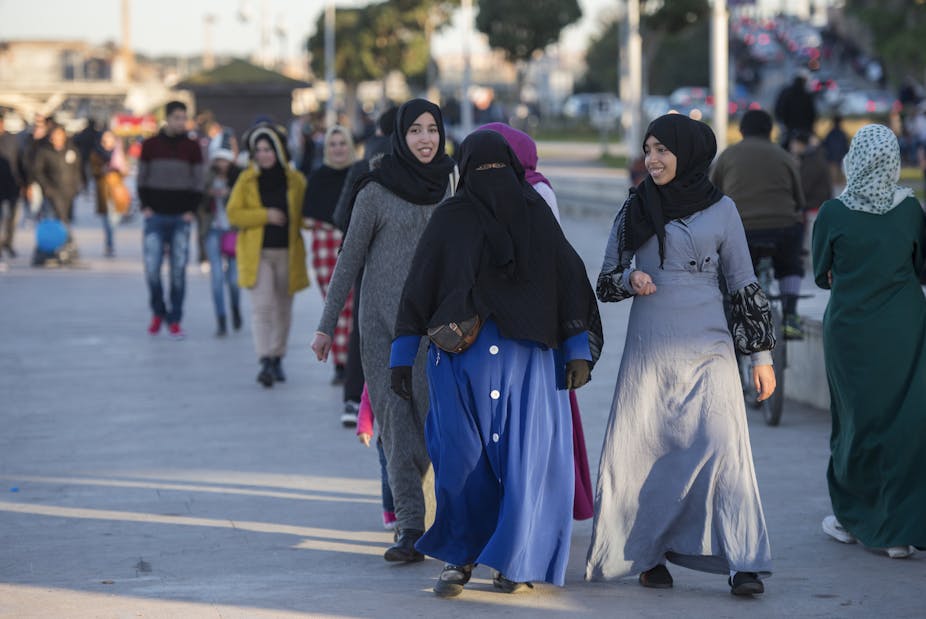Moroccan authorities have recently banned the manufacturing, marketing and sale of the burqa – an outer garment worn by some Muslim women to cover themselves in public. It completely conceals the face, with a mesh cloth shielding the eyes from view.
The decision is noteworthy in a country whose population is 99% Muslim. So what does the ban mean?
The Moroccan Ministry of Interior cited security concerns as the reason for the ban. It argued that wearing the burqa could help criminals and terrorists hide their identities. Indeed, several criminals have reportedly used the burqa or niqab – a veil that covers the face but not the eyes – to perpetrate crimes, including theft.
But beyond immediate security concerns, the real worry for the moderate Moroccan government is the spread of radical, Salafist Islam. Salafism has been linked to ISIS and terrorism in North Africa. Morocco’s concern with terrorism is exacerbated by the fact that it receives about 10 million visitors a year and partly depends on tourism revenues for its development. The government believes that banning the burqa will limit expression of radical Islam and will help contain it.
Women’s wear tells a story
A very small minority of women wear the burqa in Morocco – a country where modernity and tradition live together and whose king, Mohammed VI, fosters moderate Islam.
The djellaba – a hooded robe – is the historical, national garment of Moroccan women. It’s traditionally worn with a veil called a litham and worn together they cover the woman’s face and body, except her eyes. During the fight for independence, especially in the 1940s, the djellaba was a symbol of nationalism and a shield of identity.
Today, the djellaba is mostly worn without the litham.
But with the rise of political Islam in the mid-1980s came various new, foreign veiling practices – including the hijab, the niqab and the burqa. Under the influence of the Gulf nations, the hijab – a scarf that covers the hair – gradually infiltrated Moroccan society and came to be worn along with the djellaba or other western-type clothing.
Like the hijab, the niqab and the burqa are linked to the spread of Salafist Islam in North Africa. The niqab and burqa are worn especially in radical Islamist or Salafist circles in conservative regions in the north of Morocco. Hundreds of jihadists have travelled from this region to fight in Syria and Iraq .
Within this context, the burqa is perceived by many Moroccans as alien to their culture. Among intellectuals in general – except the ultra conservative Salafists – the wearing of the burqa is perceived as an unwelcome Wahhabi practice.
Opinions split
It’s notable that the ban hasn’t created a mass outcry. This can probably be attributed to the decision to ban the sale and production of burqas, rather than the burqa itself – at least for the time being. But the burqa ban has certainly split opinion in the country.
The Salafist extremist Abu Naim issued a video on his Facebook page calling those who made this decision “infidels, apostates and renegades who are leading a war against God”.
Some Salafist Muslim groups like Annahda wa Al Fadila (Renaissance and Virtue) have strongly criticised the move. They warn that the burqa ban is a first step towards banning the niqab. This, they argue, would lead to a real split in Moroccan society, where more women wear the niqab.
Progressive women’s organisations argue that the ban is justified because the burqa oppresses women. Nouzha Skalli, a former Minister for Family and Social Development, welcomed the ban and described it as “an important step in the fight against religious extremism”. Saida Drissi, Chair of the Democratic Association of the Women of Morocco, pointed out that “when it’s about wearing a hijab, a burqa, Salafists all agree… but we never hear them [protest] when a girl can’t wear a miniskirt”.
Others reject the burqa as a neocolonial import from the Gulf states.
The Northern Moroccan National Observatory for Human Development considered the decision “arbitrary” and an “indirect violation of women’s freedom of expression”.
But for the Amazigh researcher and activist Ahmed Assid the ban of the manufacture and sale of the burqa is legitimate and desirable. He welcomed the move because this foreign garment has been used improperly to aid criminal and terrorist acts.
The new paradox and women’s rights
The burqa ban and the debate that it has fomented has drawn attention to the tension that exists in Morocco between official moderate Islam and conservative Islam, which is a growing minority.
This is the new paradox in Morocco. And it has significant implications for women’s rights. On the one hand, recent legal and institutional reforms have had a significant impact on democracy and the modernisation process in Moroccan society. These include the amended constitution of 2011, which guarantees gender equality and women’s political participation, and the reform of the Family Code in 2004.
On the other hand, the Salafists who defend the burqa and the niqab want to Islamise society further. They ultimately aim to establish the Islamic caliphate in Morocco, which allows beheadings, the captivity of women, sexual jihad, and anti-women fatwas.
Given this paradox, the burqa ban, which favours moderate Islam and secularism, is significant. Although it’s obviously motivated by security concerns, the ban is part of a broader fight against religious extremism and terrorism.

